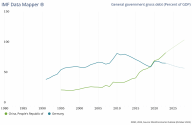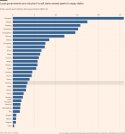You are using an out of date browser. It may not display this or other websites correctly.
You should upgrade or use an alternative browser.
You should upgrade or use an alternative browser.
Chinese Economics Thread
- Thread starter Norfolk
- Start date
China is still adding leverage at a high rate. Added Germany for comparison.
View attachment 120347
I'm not impressed by America's addiction to debt but it's not like China can lecture the US for much longer. Both countries need a significant fiscal deficit reduction path.
The total debt amount or debt to GDP ratio isn't the only thing that matters in this conversation, but also how likely a country is to repay its debt (due to how much comprehensive savings and available money it has stashed) + what its used for (is the debt 'productive', will it be able to generate 'new money', repays itself in some way further down the line for the government and the country).
China is using its debt to raise productivity long term (various world-leading infrastructures for improved economic connectivity, universities, technological incubators, for a more skilled workforce, etc...), and in most cases its infrastructure debt repays itself.
Meanwhile, the US is adding debt (printing money) to repay an old debt and patch up trade and government deficits (remember unlike China they didn't have a single government or trade surplus year in decades) to give to its divided population for 'free' and for short term consumption to pacify them and stop a civil war from happening and continue the giant charade (that's their entire 'GDP' btw).
(Overpriced military and medical spending, student loans, now even 'reparations', single mothers and unemployment benefits, etc...).
As for how much one of them is more likely to repay its debts than the other one, just look at these facts; China is the largest net creditor in the world, the US is the largest net debtor in the world, China has the largest foreign reserves in the world, trillions more in sovereign wealth funds, trillions more in regional banks, trillions more in social security funds, in citizens' personal savings, etc). They could all be used for repayment.
Last edited:
That graph above could be explained by the fact that Germany has already probably built (maximized) all of their infrastructure capabilities, for their size and circumstances, unlike China, so the ROI of them taking more government debt for infrastructure isn't as appealing as it is to China (same logic for various educational and workforce improvement spendings). It doesn't mean that they lead a better fiscal policy or are smarter.
Glenn made a very good dive into Chinese LGFVs.
This being the 'last' of a series of 5 posts about it.
Overall though, people shouldn't be as worried as western media and the likes makes it 'out to be'.
Actually, for news about Chinese debts and the likes, just do like with most western news, throw it in the garbage bin.
This being the 'last' of a series of 5 posts about it.
Overall though, people shouldn't be as worried as western media and the likes makes it 'out to be'.
Actually, for news about Chinese debts and the likes, just do like with most western news, throw it in the garbage bin.
South China's Hainan province registered a 9.5 percent growth-the highest among these regions, followed by Inner Mongolia autonomous region (7.2 percent), Gansu province (6.6 percent) and Sichuan province (6.5 percent).
Northeast China's Liaoning province saw its GDP growth stand at 5.3 percent in the first nine months.
How come Inner Mongolia, Gansu And Liaoning all mining and heavy industry dependent provinces grew so much? These provinces are considered laggards, not innovative and rust belt areas.
Inner Mongolia is where military corporations are based. Either China is expanding military faster or they are receiving more international arms deal?
South China's Hainan province registered a 9.5 percent growth-the highest among these regions, followed by Inner Mongolia autonomous region (7.2 percent), Gansu province (6.6 percent) and Sichuan province (6.5 percent).
Northeast China's Liaoning province saw its GDP growth stand at 5.3 percent in the first nine months.
How come Inner Mongolia, Gansu And Liaoning all mining and heavy industry dependent provinces grew so much? These provinces are considered laggards, not innovative and rust belt areas.
Also China's mineral extraction and processing operations are more and more integrating Huawei 5G for remote monitoring, remote operation, and automation. There are naturally going to be efficiency gains from that.Inner Mongolia is where military corporations are based. Either China is expanding military faster or they are receiving more international arms deal?
Inner Mongolia has a lot of natural resources and not that many people. It's not a laggard at all, it's the 8th richest province in GDP per capita terms, just behind Guangdong. China is consuming quite a bit more coal than last year with growth of 5.5% in the first half. That's probably the biggest driver of the economy of inner Mongolia
South China's Hainan province registered a 9.5 percent growth-the highest among these regions, followed by Inner Mongolia autonomous region (7.2 percent), Gansu province (6.6 percent) and Sichuan province (6.5 percent).
Northeast China's Liaoning province saw its GDP growth stand at 5.3 percent in the first nine months.
How come Inner Mongolia, Gansu And Liaoning all mining and heavy industry dependent provinces grew so much? These provinces are considered laggards, not innovative and rust belt areas.
Gansu is actually poor, so it's growing from a low base.
In general, a lot of factory work is shifting from richer coastal provinces with expensive workers to poorer provinces with cheap labour. So we should expect to see the laggards continue to catch up and inequality reduce



